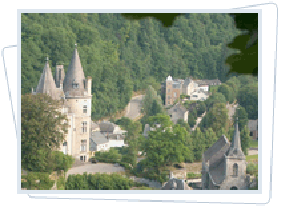European tourism gardens of Eden

Another three European destinations of excellence
Durbuy (Belgium-Wallonia)
View of Durbuy © Durbuy
The district of Durbuy is located in southern Belgium, Wallonia, at the foot of the Ardennes. It is made up of 40 small villages and hamlets and gets its name from one of the most important villages in the area.
For more than 150 years, the town has been famed for its cuisine, bringing in connoisseurs from far and wide. It is one of the driving forces behind Durbuy’s tourism economy. Numerous products are produced locally, which means the markets in other villages can also be patronised.
Durbuy has been recognised as a “town” since the Middle Ages in view of the important legal bodies and commercial activities there. And so it was that the old town of Durbuy became known as ‘the smallest town in the world’, putting this humble corner of the Belgian Ardennes firmly on the map.
Situated at the intersection of three geological regions, Durbuy offers a startling array of landscapes. Shaped by the elements, the area offers majestic and often untold panoramas, such as Roche-à-Frêne, or the view of the Falize in Durbuy’s old town. Caves run along the Ourthe and its tributaries, such as the Coléoptère cave in Juzaine, or the cave in Bohon or Villers Ste Gertrude
The forests, densely populated with hardwood, house an extraordinary range of flora and fauna, and it is here that local authorities have laid down 175km of walking paths.
Mainly managed by small family businesses, the accommodation sector welcomes many tourists.
Visitors will find a range of accommodation adapted to taste, length of visit and reason for stay: hotels of all types, classic or with an unusual personal touch, charming or unique guestrooms, camping areas, group accommodation, places for businesspeople for seminars or team-building exercises, rural cottages, farms or holiday villages…
Durbuy plans to:
- Improve the welcoming of tourists
- Support the local economy through tourism
- Favour out-of-season tourism
- Protect the quality of the natural environment for each attraction and activity
- Manage visit fluctuations during peak periods
- Reduce the pressures on fragile areas from tourism
- Guarantee the water quality in river areas suitable for bathing
- Stimulate cultural tourism
- Mitigate the various types of urban and visual pollution within the territory
- And…
- Raise awareness among tourists of their responsibilities.
WEBSITE: www.durbuy.be/
MORE AT EDEN WEBSITE
SEE VIDEO
Pielachtal (Austria)

Cherries © pielachtal.jpg
In the Pielachtal, culture, nature, way of life, handicrafts and specialty foods are combined to form a network of innovative offers.
The Dirndl (pl. Dirndln), or Cornel, popularly known as a cherry, although it is in fact a very old and healthful species of its own, is cultivated as the valley’s “trademark”. The Dirndl is presented as a tourism attraction and introduced to guests in a manner at once entertaining and educational.
With initiatives for soft mobility, co-operative projects joining together agriculture, handicrafts and tourism, as well as a sustainability report that is nationally unique, the Pielachtal succeeded in demonstrating that it deserved the title of Austria’s best emerging rural destination.
The Pielachtal is located in the Mostviertel region of the province of Lower Austria. The Mariazellerbahn railroad runs through the Pielachtal connecting the provincial capital St. Pölten and Mariazell.
The valley has some 800 beds and records about 42,000 room nights per year. The Pielachtal is known for its beautiful landscape, as well as its exemplary sustainable development.
In Pielachtal sustainability is a tradition. Farming shaped the life of the valley in the past and continues to do so today. Human activity revolved around cattle, chicken and sheep, herbs and fruits, in particular the most typical fruit of the area, the cider pear.
Guests are invited to learn to “read” the landscape and discover the interrelationships between nature and agriculture. They have the opportunity to learn about the principles and advantages of sustainable horticulture and the processing of fruits and herbs.
Two extraordinary vacation hotels have been created in the area:
Steinschalerhof and Steinschaler Dörfl (a small village on a mountain).
Both hotels were originally farms and combine a high level of comfort with an emphasis on sustainability.
WEBSITE: www.pielachtal.info/
MORE AT EDEN WEBSITE
SEE VIDEO
Sveti Martin na Muri (Croatia)

Wooden house © Sveti Martin na Muri
2525 hectares in size and with a population of 3154, the district of Sveti Martin na Muri is located in the northernmost point of the Republic of Croatia, close to the tri-border with Slovenia and Hungary, where the River Mura enters the territory of Croatia.
Serious developments in tourism began in 2005 when the Sveti Martin Spa was built; it is the largest and one of the most beautiful spas in Croatia. In addition to tourist attractions this development also enjoys the support of a good quality communal infrastructure.
Key attractions include:
- the wine road, with some 30 wine houses, ranks as one of the best of its type in “Martinje”: celebration of wine and gastronomy;
- the Vincek campaign: wine competition in January;
- Days of Međimurje Cuisine.
- International Pannonian Cycling Marathon through three countries (Croatia, Hungary, Slovenia) in July;
- International Marathon of Mura boats, from Murek in Austria to Sveti Martin na Muri (participants from Austria, Croatia, Hungary and Slovenia) in June; International Equestrian Tournament, in August;
WEBSITE: www.svetimartin.hr/
MORE AT EDEN WEBSITE
SEE VIDEO
Valere Tjolle
Valere Tjolle is editor of the Sustainable Tourism Report Suite – special offers HERE
 United Kingdom
United Kingdom United States
United States Asia Pacific
Asia Pacific












































Dozens fall ill in P&O Cruises ship outbreak
Turkish Airlines flight in emergency landing after pilot dies
Boy falls to death on cruise ship
Unexpected wave rocks cruise ship
Woman dies after going overboard in English Channel